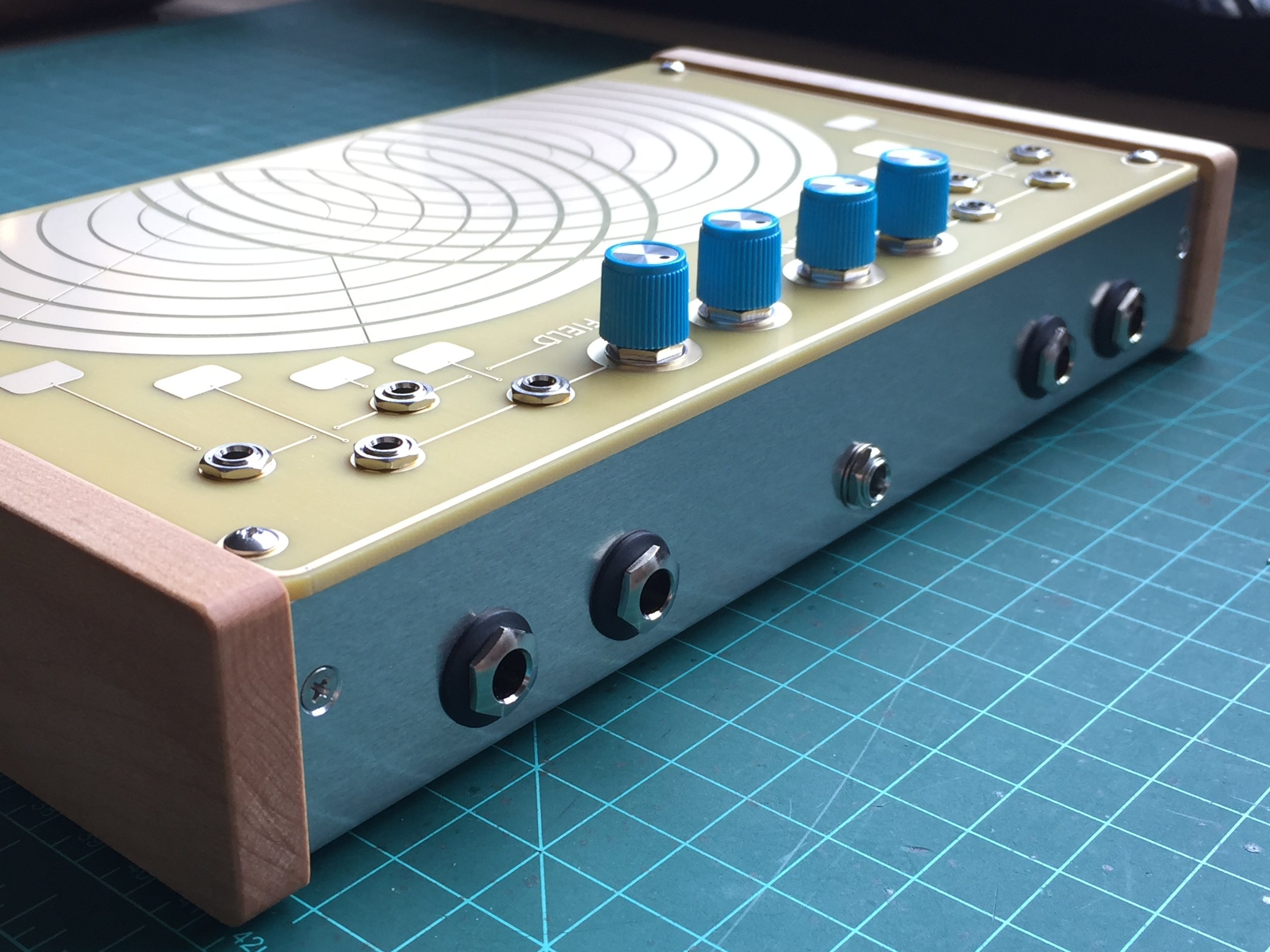STEREO FIELD
STEREO FIELD is one instrument with three uses. It is simultaneously a stereo/quad modular touch plate feedback atonal synthesizer, a stereo/quad audio processor and a pressure sensitive chaotic CV "controller". All three uses are available separately as well as simultaneously and in conversation with each other. The Stereo Field allows its user to manipulate and patch two analog stereo preamp circuits via touch plates. By utilizing skin conductivity as new paths for current to follow you are creating "new circuits" and new sounds in relation to where your fingers are patching. The individual touch plates are directly connected to nearly every connection point of every component in its circuitry (located directly under each corresponding touch plate). When touched with multiple fingers it will create atonal analog feedback with either of the two mirrored circuits represented by interlocking touch-plate circles. The resulting feedback can go beyond the abilities of human hearing (Take caution!) and down to the very slow clicks of a saw waveform and both can often be happening simultaneously . These parallel mirrored circuits can be finger patched separately or together yielding vastly different chaotic results in regards to texture, timbre and stereo imaging. This instrument has the ability to create atonal synth tones in stereo (and quad) as well as process incoming stereo audio (and quad) sources via 1/4" and 3.5mm ins and outs. Incoming audio sources can be "patched" or rewoven into any area of either or both of the circuits via skin contact. The two stereo input volume knobs (center) shape and effect distortion, drive amounts, internal feedback pitch, and modulation rates depending on how your fingers are patching. The quad inputs and outputs via the 3.5mm jacks have small touch plates leading to and from allowing for touch access of each of the 4 inputs and 4 outputs. If multiple audio signals are traveling into the Stereo Field these audio sources can be intermingled and can modulate one another, again depending upon where your fingers are patching. Sending CV signals into the 3.5mm input jacks will open up many more possibilities both in terms of synthesized sounds and audio processing. Since the two stereo circuits are mirror images of one another the 3.5mm ins and outs can also be thought of as (L/R,R/L) and when your hands get involved this imaging will be further confused and jumbled as your skin can intermingle all of these paths. The Stereo Field can also be used as a controlled chaos source when using the 3.5mm outputs to send the feedback your hands create as CV to your modular system. Due to the nature of feedback and finger patching the 4 available CV signals have the ability to get incredibly complex, organic and textured in nature (see audio examples below in use with a euro-rack system). Because of the open nature of Stereo Field it can both send and receive CV modulation simultaneously. In addition, this can all be happening while your finger patching is changing and altering the incoming and outgoing CV while also processing incoming audio. These ins and outs can also be patched together with cables for sustained tones with the pitch/rhythm/volume/"cutoff" being affected by adjusting the incoming and outgoing volume knobs in various settings. Inter-patching in this way will also allow for sustained pulse beats and filter-esk sound shaping in addition to bringing new results to finger patching via the touch plates. Most importantly, processed audio and synthesized audio are available simultaneously with the ability to influence and modulate each other. This will often blur the lines between the two; who is manipulating who? who comes out on top as audio and who is modulation? This can be a constantly evolving cycle based upon where the performers fingers are placed and highly sensitive skin contact pressure changes.
The sound is sometimes easy to describe; (distortion, filtering, resonance, high-pass, lo-pass, feedback, sine waves, square waves, pulse width modulation, formants, white noise, pink noise, metallic noise, stereo rhythms, wave-folding, frequency modulation, amplitude modulation, spacial shifts, panning, sub octaves, pitch following) but most of the time these definitions fall "between effects" or in combinations of multiple effects that can be shifting, feeding back or pulsing in sync with incoming audio during processing. Since the user is directly touching analog circuitry through gold touch plates, shifts in pitch/timbre/stereo/drive/modulation can be accessed instantly. The stereo (or quad) imaging of the instrument is both influenced by feedback and modulation in regards to where your fingertips are patching along with modulation caused by incoming audio content. In addition to the sheer number of patching and finger pressure combinations available, the instrument has shown theremin-esk properties in certain settings due to the large surface area of the gold plates. To bring this even a step further the synth/modulation/processing tones can be triggered by only breathing on the plates using the moisture content of breath to partially control and sculpt the audio.
There is a type of collaboration that happens with the Stereo Field as sometimes you will be reacting to what it is doing and other times you will be attempting to control and shape what it is doing but most of the time you will be doing both simultaneously.
**STEREO FIELD INSTRUCT_PDF
-additional important information can be read on the "Why" page.
SPECIFICS:
-10" x 5.75" x 1.5" Aluminum and Maple enclosure
- Immersion gold touch plate interface
- Circuits based around new old stock analog ICs which were originally designed for car stereos
- Completely analog design
- Stereo 1/4" L/R inputs, 1/4" L/R outputs on rear of unit (outputs/inputs audio through both circuits)
- Quad 3.5mm inputs (2x L/R mirrored pairs corresponding to each of the two circuits, can be used for CV, audio or both)
- Quad 3.5mm outputs (2x L/R mirrored pairs corresponding to each of the two circuits, can be used for CV, audio or both)
- As a CV "Controller" it will output approximately 4.2v to -2.8v depending on hand placement and input/output volume settings.
- 8 x touch plates corresponding to each of the 8 x 3.5mm jacks for touch interaction with i/o cable patch points
- 2 x stereo input volume knobs (for vastly changing touch plate interaction as well as incoming audio/CV levels)
- 2 x stereo output volume knobs (for changing touch plate interaction as well as outgoing audio/CV levels)
- 12v Regulated (tip +) grounded power supply (100-240V AC)
- Light weight: 1lb 11oz
-Price: $445
NOTE: Landscape shall not be held accountable for injury or worse when not using common sense with electricity. Do not use anything besides the included power supply or a 9v battery adaptor to power the Stereo Field. We recommend plugging into a mixer or modular synthesizer. Do not plug directly into a PA system or power amp. The Stereo Field should only be played utilizing skin contact. Avoid introducing other metal objects or liquid to the surface as you may possibly damage the surface finish and/or the circuits.
NOTE II: Noise is a common issue with touch plate instruments. In most studio situations the Stereo Field will respond fairly well but there is a possibility of ground hum and RF interference given the open nature of the device and depending upon any given location. It is sometimes helpful to power the Stereo Field with a 9v battery adaptor (to 2.1mm DC connector). Consider running the Stereo Field through a stereo DI box that can "float ground" before going into your mixer or grounding the chassis of the Stereo Field to the chassis of your mixer if you have ground loops in your environment. Plugging the power supply into the same power strip as your mixer can sometimes help a bit.





